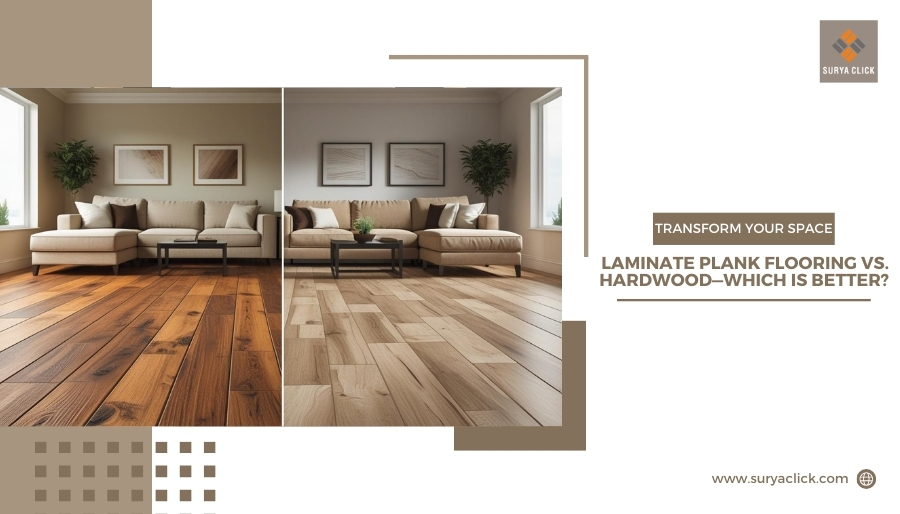When it comes to transforming your home’s interior, flooring plays a far bigger role than most people think. It not only influences the style and feel of your space but also affects durability, maintenance needs, comfort and even your property’s resale value.
In India, two of the most popular choices are laminate plank flooring and hardwood flooring. Each comes with its own strengths, drawbacks and ideal use cases. The key is to choose based on your lifestyle, budget and the specific conditions of your home.
This guide compares both options in detail so you can make an informed decision that enhances both the beauty and functionality of your space.
Laminate Plank Flooring
Laminate plank flooring is a multi-layered product designed to replicate the look of real wood at a fraction of the cost. It typically consists of:
- Wear Layer: A transparent, durable coating that protects against scratches, stains and fading.
- Design Layer: A high-resolution photographic image in paper of wood (or stone) for a realistic look.
- Core Layer: High-Density Fibreboard (HDF) that provides strength and stability.
- Backing Layer: A moisture-resistant base that helps prevent warping.
Laminate flooring offers the appearance of hardwood but is generally more affordable, durable and easier to maintain.
Hardwood Flooring
Hardwood flooring is quite a sturdy type of flooring. It is made from solid wood. It can be oak, maple, cherry or walnut. It comes in planks— usually around 19 mm thick. These can be sanded and refinished many times during their lifetime. Hardwood is Valued for its natural beauty and warmth. It is also known for its strength and ability to enhance a house.
1. Appearance and Aesthetics
Hardwood Flooring:
Natural wood is known for its looks and feel. Hardwood has a rich, timeless beauty. Each of these planks is unique with respect to grain, color variation and texture. It is also capable of being stained in varying shades or worn to fit your decor.
Laminate Flooring:
Modern laminate flooring uses advanced printing and embossing technology to closely mimic the look of wood. While it can look very realistic, it is also comparatively cheaper.
2. Durability and Resistance
Hardwood flooring:
Hardwood is rather durable. But it can get damaged due to scratches, dents, etc. It can also be harmed by water. It’s durable in low-traffic, climate-controlled environments, but can be vulnerable to changes in temperature and humidity.
Laminate flooring:
Laminate flooring is built solidly to resist everyday use, dents, scratches and even sometimes a bit of spill. The majority of the varieties are either water-resistant or waterproof. So, you can use them in the kitchen, bathroom and basement.
3. Maintenance and Cleaning
Hardwood Flooring:
It needs to be regularly swept and sometimes mopped. A stain should be avoided by cleaning spills as fast as possible. It can become dry over time and require refinishing to restore its original condition.
Laminate Flooring:
Extremely easy to clean up–can simply be swept or vacuumed and then mopped with a wet cloth. However, they should not be cleaned with excessive water.
4. Installation Process
Hardwood Flooring:
The installation is time-consuming and sometimes professional assistance is required. Planks are normally nailed/ glued across and the subfloor has to be really level. Proper acclimatization prior to installation should also be done to avoid warping.
Laminate Flooring:
A large number of laminate flooring products are compatible with click-lock systems, enabling self-installation. It is hung above the subfloor with no need for nails or glue. It is more economical to install.
5. Cost and Budget
Hardwood Flooring:
This is one of the high-end flooring choices. Material cost and installation are pretty expensive. However, this depends on the wood variety and finish.
Laminate Flooring:
It is an inexpensive option. It is very reasonable to and easy to install saving a lot of money.
6. Environmental Impact
Hardwood Flooring:
Hardwood is naturally made; it is made from a natural tree and can also be used in a sustainable manner; it is easily biodegradable. It can last a lifetime if maintained well, reducing waste. However, its production process contributes to deforestation, except when it is made available in a sustainable way.
Laminate Flooring:
Laminate is composed of HDF boards and adhesives. There are brands that utilize recycled material.
7. Lifespan and Long-Term Value
Hardwood Flooring:
Hardwood can last 50–100 years, provided it is maintained properly. It is a material that can be sanded and refinished multiple times. This keeps it in a new condition for many decades. It also increases the value of the real estate of a home.
Laminate Flooring:
Laminates tend to last 10-30 years. This is quality-dependent and usage-dependent. It does give a home a decent value.
Conclusion
Find out what you need, what you prefer and what your budget will support. Keeping these parameters in mind, choose which one matches your preferences. A balance of the two in a number of situations can provide the best results. Whichever one you decide, replacing your floors is an effective means to imbue and improve the personality and utility of your home.

